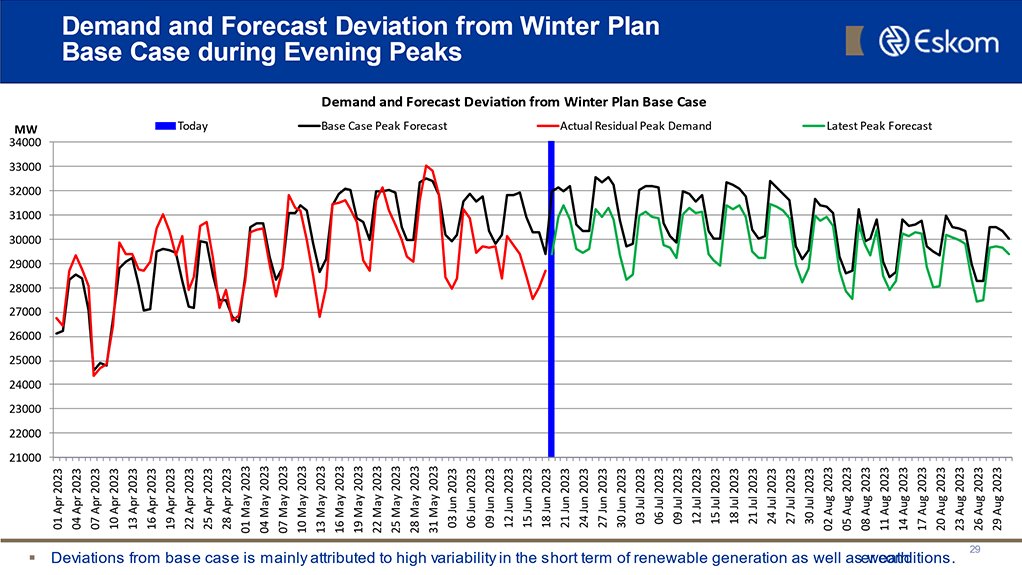Weather and winter tariff on large users helping to moderate electricity demand


Electricity demand and Eskom's forecast of how electricity demand during winter 2023 will deviate from its winter base case
Photo by Eskom
Eskom is expecting demand for the rest of South Africa’s winter months to remain below levels initially assumed when the utility finalised its base case for the high-demand season (see graphic above), while it is also beginning to report improved generation performance at some of its coal stations.
When Eskom unveiled its winter outlook on May 18, it warned that it might be forced to resort to Stage 8 loadshedding (representing 16 hours of cuts in a 32-hour cycle) should it fail to cap coal plant breakdowns to below 15 000 MW and should demand spike on the back of colder temperatures, particularly in Gauteng.
Eskom’s Eric Shunmagum reports that there have been favourable developments on both fronts, with demand having moderated from the 33 000 MW peak experienced in late May and supply having also improved from both Eskom and renewables plants.
The May peak preceded the implementation of the winter tariff, implemented on large energy intensive businesses as from June 1.
Shunmagum says Eskom has not yet calculated the full effect of the winter tariff but estimates that demand is likely to have dropped by between 850 MW and 1 000 MW as a result of large industrial plants having shut down in line with the introduction of the tariff. The utility is also pursuing a demand-side management campaign through which it hopes to shave a further 1 000 MW from consumption over the coming few months.
He stresses, however, that the main reason for the current deviation from the winter demand base case is attributable to weather conditions which have also supported the availability of some renewables generators. The wind fleet in particular, has performed strongly during recent cold fronts, supplying up to 2 000 MW during evening peaks on certain days.
While Gauteng could still face a cold snap, which could drive up demand significantly, the utility is nevertheless expecting peak demand to remain below the base case peak forecast outlined in May for the rest of the winter period to September. The utility’s latest peak demand forecast does not show demand rising above 32 000 MW again this winter.
Shunmagum stresses, however, that there have also been improvements on the supply side, with unit breakdowns, which were trending at between 18 500 MW and 19 000 MW in May, currently trending between 14 500 MW and 16 000 MW.
“So, there's at least a 3 000 MW improvement on breakdowns,” he states.
Ahead of winter, the generation division outlined a goal of sustaining breakdowns to below 15 000 MW and of capping planned outages to below 3 000 MW to limit loadshedding, as well as the use of diesel at the open cycle gas turbines.
“There has definitely been an improvement in generation performance,” he says, reporting particularly pleasing turnarounds at Tutuka, Duvha, Kendal and Majuba.
On the supply-side, Eskom has also welcomed the decision by the Department of Forestry, Fisheries and the Environment to grant Kusile a postponement in meeting sulphur dioxide minimum emission standards.
The postponement means that Eskom will be able to operate temporary stacks at the three units rendered inoperable after the Unit 1 flue duct collapsed on October 23, owing to a build-up of slurry. The collapse also compromised the unit 2 and 3 flue ducts, which share a chimney with the Unit 1 flue.
Under the updated Atmospheric Emission Licence, Kusile will be able to bypass the flue gas desulphurisation plant until March 31, 2025 and resume output using temporary stacks that will be returned to service in November (Unit 3) and December (Unit 1 and Unit 2).
The units will not be introduced at full load of about 720 MW, however, and will produce at about 520 MW apiece while employing the temporary stacks.
The utility is planning to complete repairs to the ducts in the permanent stack by December 2024.
Article Enquiry
Email Article
Save Article
Feedback
To advertise email advertising@creamermedia.co.za or click here
Comments
Press Office
Announcements
What's On
Subscribe to improve your user experience...
Option 1 (equivalent of R125 a month):
Receive a weekly copy of Creamer Media's Engineering News & Mining Weekly magazine
(print copy for those in South Africa and e-magazine for those outside of South Africa)
Receive daily email newsletters
Access to full search results
Access archive of magazine back copies
Access to Projects in Progress
Access to ONE Research Report of your choice in PDF format
Option 2 (equivalent of R375 a month):
All benefits from Option 1
PLUS
Access to Creamer Media's Research Channel Africa for ALL Research Reports, in PDF format, on various industrial and mining sectors
including Electricity; Water; Energy Transition; Hydrogen; Roads, Rail and Ports; Coal; Gold; Platinum; Battery Metals; etc.
Already a subscriber?
Forgotten your password?
Receive weekly copy of Creamer Media's Engineering News & Mining Weekly magazine (print copy for those in South Africa and e-magazine for those outside of South Africa)
➕
Recieve daily email newsletters
➕
Access to full search results
➕
Access archive of magazine back copies
➕
Access to Projects in Progress
➕
Access to ONE Research Report of your choice in PDF format
RESEARCH CHANNEL AFRICA
R4500 (equivalent of R375 a month)
SUBSCRIBEAll benefits from Option 1
➕
Access to Creamer Media's Research Channel Africa for ALL Research Reports on various industrial and mining sectors, in PDF format, including on:
Electricity
➕
Water
➕
Energy Transition
➕
Hydrogen
➕
Roads, Rail and Ports
➕
Coal
➕
Gold
➕
Platinum
➕
Battery Metals
➕
etc.
Receive all benefits from Option 1 or Option 2 delivered to numerous people at your company
➕
Multiple User names and Passwords for simultaneous log-ins
➕
Intranet integration access to all in your organisation















